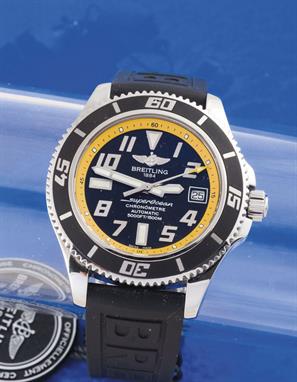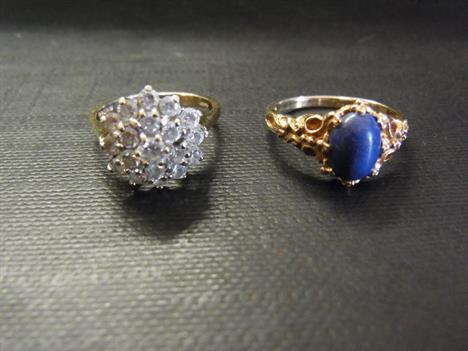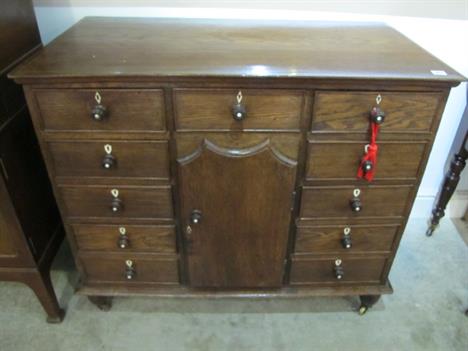Plat, mokhfia, Maroc, Fès, signé et daté 1332H./1913 Grand plat en faïence, à décor polychrome et rehauts de minium, d’un large octogone inscrit dans un polylobe bordé de compositions florales et de motifs en esse. Frise de quadrilobes au rebord. D. : 50,5 cm État : fracture et réparations par cordage recouvertes de minium.Provenance : collection J. M. G., Paris.Dish, Mokhfia, Morocco, Fez, signed and dated 1332 H / 1913
We found 375851 price guide item(s) matching your search
There are 375851 lots that match your search criteria. Subscribe now to get instant access to the full price guide service.
Click here to subscribe- List
- Grid
-
375851 item(s)/page
A pair of Edwardian silver candlesticks, hallmarked Birmingham 1901, maker's mark of M & Co. Each with cast scrolling decoration. One 12.5 cms high, the other 12 cms high. (2) CONDITION REPORTS: The smaller with soldered repair beneath central knop, the other with a plain band beneath the central knop, some denting, scuffing and scratching, loaded weight approximately 10.5 ounces.
Gerard Dillon (1916-1971) HOME WITH THE CATCH oil on canvas signed lower right 23 by 23.5in., 57.5 by 58.75cm. L Waddington Galleries, Dublin;Where purchased by the present owner`s father Four Ulster Painters`, Victor Waddington Galleries, Dublin, September, 1947;`Four Ulster Painters`, Heals Mansard Gallery, London, May to June 1948, catalogue no. 36 (a joint exhibition with Daniel O`Neill, George Campbell and Neville Johnson);`Gerard Dillon, Art and Friendship Summer Loan Exhibition`, Adam`s, Dublin, 2-26 July 2013 (travelled to Ava Gallery, Clandeboye, 1-29 August 2013) catalogue no. 39 Gerard Dillon, Art and Friendship Summer Loan Exhibition`, Adam`s, Dublin, 2013, catalogue no. 39, p.41 (illustrated) Gerard Dillon was born in West Belfast in 1916 but spent much of his life in London where he earned a living as a painter and decorator. Many of his most popular, and important, paintings depict scenes of everyday life on the west coast of Ireland. He first visited the west in 1939 and became enchanted with the landscape and the people, making them the major theme of his work throughout the 1940s and 1950s. Home with the Catch is a western scene where a young family make their way through the village with their daily catch of fish. Fish were both a staple of their diet and a commodity that they could trade. Their clothing is recognisable as the traditional dress once common in Connemara and the Aran Islands. The woman`s red skirt and white woollen jumper along with the man`s baggy woollen trousers and waistcoat and their simple leather shoes, known as pampooties, locate this image in a particular time and place. Stylistically similar to Irish Peasant Children (c.1949), this work also resembles the young couple carrying fish depicted in Dillon`s textile work Gentle Breeze, which he hand stitched in 1952. Recalling his first experience of the western seaboard, Dillon wrote that the west was `a great strange land of wonder to the visitor from the red-brick city`.(1) Like many artists and writers before him, he held a romantic view of the west as both the locus of an authentic Irish culture and a `primitive` place, free from many of the restraints of wider Irish society. Writing in 1955, he claimed that Connemara is `the place for a painter` and eulogising about the variety of the rugged landscape, the quality of the light and the simplicity of daily life, concluded: `one could live here forever but being neither a fisherman nor farmer, but only a painter, I`m forced to come back to city life to sell work - and hope to save enough to come back to Connemara`.(2) Although Dillon recognised that he was an outsider in Connemara, during the period he spent living on Inishlacken in 1950, he adopted elements of traditional dress, travelled back and forth to the mainland in a currach and embraced the way of life wholeheartedly. As James White pointed out: `For a nationalist Catholic like Gerard Dillon, living in London and desperately wanted to belong to a Republican nation called Ireland ... Connemara with its remoteness, its delightful stonewall fields, mountains, lakes and seacoast and above all islands like Inishlacken where he could cut himself off for a spell and live in a tiny cottage, with no social life to speak of and a boat journey away from barracks, church or pub - all this gave him the feeling of having found a land free of all the restrictions of oppression which he had come to accept as being there to offend him`.(3) Dillon`s initial interest in painting the west and its inhabitants was sparked by Seán Keating`s illustrations for Playboy of the Western World. William Conor`s focus on the daily lives of working people in Ulster was another early influence. In Home with the Catch, Dillon brings these influences together to create an original vision of the west which combines romance and realism. Dr Riann CoulterApril 20141 Gerard Dillon, `The Artist Speaks`, Envoy, 4 February, 1951, p.39.2 Gerard Dillon, `Dear Tourist`, Ireland of the Welcomes, Bord Fáilte, Dublin, May/June, 1955, p.30.3 White, James, Gerard Dillon: An Illustrated Biography, Dublin: Wolfhound Press, 1994, p.10.
ZENITH (Chronographe Trois compteurs Pilote), vers 1967 Beau chronographe de pilote à grande ouverture en acier à fond vissé (décoré de l`étoile stylisée), dans la lignée des modèles Cairelli de la marque. Cadran noir à chemin minutes avec trois compteurs blancs : (seconde à 9h, minutes à 3h et compteur des heures à 6h). Lunette externe bidirectionnelle en acier noir patiné et gradué sur 60 m. Aiguilles spatule en acier et index luminescents. Bracelet de crocodile (Crocodylia spp. CITES annexe II B) rapporté à boucle Zenith. Mouvement : Calibre mécanique remontage manuel ZENITH / 146 HP (17 r.) Swiss. Diam. 40 mm. Etat : Très bon état.
CHAUMET (Chronographe Class One - XXL réf. W17790-45R), vers 2013 Imposant chronographe sportif 100 M, à large lunette unidirectionnelle en or rose graduée sur 60. Boîtier en titane à grande ouverture, larges cornes et fond vissé avec fond hublot en verre saphir (balancier apparent décoré). Cadran noir guilloché à trois compteurs cerclés en or rose 18 carats, (minute à 3h, heure à 6h et seconde à 9h), date guichet entre 4 et 5 h. Larges index appliqués et aiguilles squelette luminova. Bracelet Chaumet en caoutchouc à boucle déployante en or rose et titane d’origine. Mouvement : Calibre mécanique remontage automatique signé CHAUMET / base ETA Swiss. Diam. 44,5 mm. État : Très bon état (Écrin Chaumet, livret et certificat d’origine).
BREITLING (SuperOcéan 42 - Chronomètre 1500 M réf. A17364), vers 2013 Montre de plongée 1500 mètres réédition de la mythique Superocéan des années 1960. Boitier en acier avec épaulement, larges cornes et fond vissé. Lunette tournante unidirectionnelle graduée sur 60. Cadran noir avec de larges index et chiffres superluminova, aiguilles spatule luminescentes. Date à 3h et verre saphir. Bracelet Breitling en caoutchouc siglé à boucle déployante d`origine. Mouvement : Calibre mécanique remontage automatique signé BREITLING / 17 base Eta certifié chronomètre Swiss. Diam. 42 mm. État : Très bon état (Ecrin, certificat et livret d`origine).
ROLEX (Oyster Perpetual - Submariner 300 M réf. 14060), vers 1993/94 Montre de plongeur Submariner étanche à 300 m. Boitier en acier à fond vissé. Lunette tournante bidirectionnelle graduée sur 60 et couronne vissée avec épaulement. Cadran noir à larges index cerclés et aiguilles Mercedes luminescents. Bracelet en acier ROLEX Oyster Fliplock n°93150. Mouvement : Calibre mécanique remontage automatique signé ROLEX / Swiss. Diam. 40 mm. Etat : Très bon état (Ecrin et certificat Rolex d`origine).
TAG HEUER (Plongeur Professional 200 M - Blue), vers 1986 Montre de plongée 200 m à lunette tournante unidirectionnelle laquée bleu et graduée sur 60. Boitier en acier à débordement pour la couronne et fond vissé (logo gravée). Cadran bleu avec date guichet à 3h, aiguilles Mercedes squelette et index pastille luminescents. Bracelet en acier à boucle déployante et un bracelet N.A.T.O. en tissu. Mouvement : Calibre remontage Quartz signé T.HEUER / Eta Swiss. Diam. 37 mm. Etat : Très bon état.
A 9ct gold coral cameo brooch - Hallmarked Chester - Length 3.5cms - A seed pearl foliate bar brooch - Stamped M B & Co 9ct - Length 3.5cms - Together with a yellow metal moonstone stickpin - Tests as gold -Length 5.5cms - Total weight approx 5.7gms Condition Report: Good - With light scratches in keeping with wear.
Two 9ct cluster rings - The first set with ruby and diamond - Hallmarked Birmingham - Ring size L - The second with sapphire and diamond - Hallmarked London - Ring size M - Total weight approx 2.8gms Condition Report: Good to fair - With light dents and surface scratches - Sapphire and diamond ring slightly misshapen.
An early to mid 20th century sapphire and diamond two-stone crossover ring - the old-cut diamond and circular-shape sapphire to the asymmetric old-cut diamond shoulders and plain band - Estimated principal diamond weight 0.50ct - Estimated I-J colour, SI2-P1 clarity - Ring size M 1/2 - Weight approx 3.2gms. Condition Report: Good to fair - Light dents and scratches in keeping with age and wear - Slightly misshapen - Diamonds lively and bright - One deficient from shoulders - Sapphire with rubbed facet edges and light surface scratches.
A Cannon EOS 500 35 mm camera with Canon EF 35 - 80 mm 200 mm lens, a 72mm mirror lens, a 52 mm Sigma 200 m Skylight lens, a Kenko Vari 8000 S 420 - 800 mm lens, a Sigma 55 mm Skylight DL 200 m lens Cobra Auto 210 flash and tripod along with a Minolta XG1 with Tamron 49 mm lens, a Fujica ST 701 35 mm camera, a Galaxy 200 mm tele-lens and two Fuji lenses - 1 : 3.5 / 28 and 1 : 1.8 / 55
An 18th century North Oak Dresser, the upper section having cavetto cornice centred by a keystone within fluted pilasters, boarded back and three shelves with some original cup hooks, the base with three fruitwood cross banded drawers over a shaped apron on front cabriole legs with pad feet - Height 2.17 m x Width 2.10 m
-
375851 item(s)/page




























































